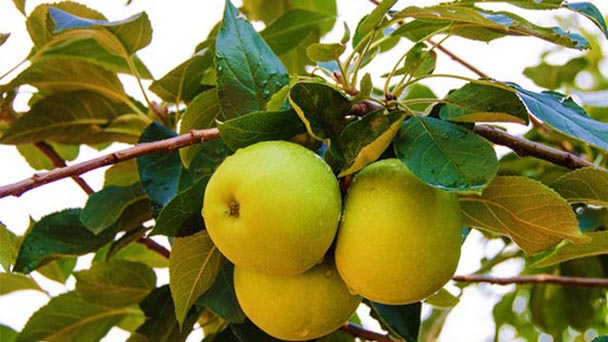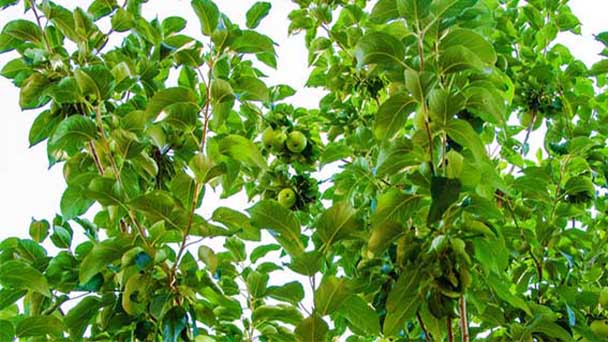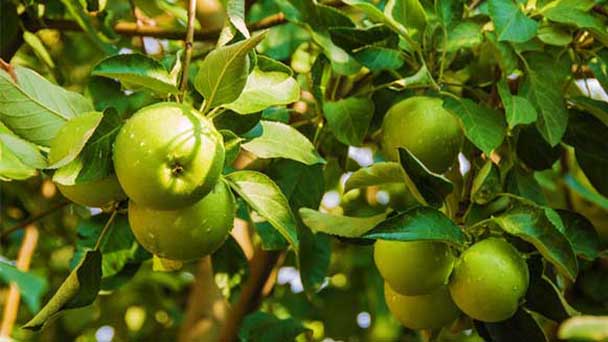Apple tree Profile
Written by Joy
Sep 27 2020

Apple trees, deciduous trees, usually can grow up to 15 meters high, but cultivated trees generally only about 3-5 meters high. The trunk is greyish-brown and the bark is peeling to some extent. The fruit is usually red, but it depends on the variety. The fruit of apple trees is rich in minerals and vitamins and is one of the most commonly eaten fruits.


Apple tree morphological characteristics
Apple trees are trees, up to 15 meters high, with a circular crown and a short trunk; Branchlets are short and thick, cylindrical, densely woolly when young, older branches purple-brown, glabrous; Winter buds ovate, apex obtuse, densely pubescent. Leaf blade elliptic, ovate to broadly elliptic, 4.5-10 cm long, 3-5.5 cm wide, apex extremely acute, base broadly cuneate or rounded, margin obtuse, both mask pubescent when young, glabrous when grown.Apple tree growth habit and growing environment and distribution
Commonly cultivated in Liaoning, Hebei, Shanxi, Shandong, Shaanxi, Gansu, Sichuan, Yunnan and Xizang of China. Suitable for hillside terraces, plain mines and loess hills, 50-2500 meters above sea level. Native to Europe and central Asia, it has a long history of cultivation, cultivated in temperate regions around the world. The average annual temperature is between 12.5 ℃ and 14.5℃, and the lowest gas temperature in winter is above -18 ℃, and the annual precipitation is 600-900 mm, which is more suitable for planting apple trees.Apple trees like deep soil, water tables below 1 meter, drought can drain and they are rich in organic matter in the middle loam. The PH of soil should be from slightly acidic to slightly alkaline. When the PH is above 7.6, iron deficiency yellow leaf disease is easy to occur. When soil ventilation is poor, root growth is hindered.
Apple tree efficacy and role
Apples contain flavonoids. Researchers in Finland published a study in October 1999, showing that flavonoids in apples are effective in reducing the risk of cancer. The vitamin C in apples is the protection of cardiovascular, heart disease patients with a healthy element. People who ate more apples were far less likely to catch a cold than those who ate none or fewer apples. So, some scientists and doctors call apples a general practitioner. Now air pollution is more serious, eating more apples can improve the respiratory system and lung function, protect the lungs from pollution and smoke.Apple tree cultivation
Choose wind and the sun, open terrain, ecological environment, less rainy weather, the best loose fertile soil, good drainage, rich in organic matter. After the establishment of the garden, the land was reclaimed, weeds and sundries were removed from the orchard, and the sloping land was planted by terrace. The seedlings of the varieties with strong adaptability, resistance and disease resistance should be selected. The roots of seedlings had better not be lost, and the planting time in rainy weather from July to September was the best, which was conducive to the survival rate of planting. Before transplanting, dig a large hole and fill in sufficient basal fertilizer, then transplanting can be done.Latest Updated
- Benefits of Bugleweed - 7 Science-backed Health Benefits
- Bugleweed Dangers & Side Effects - Is It Poisonous?
- How to Plant Evergreen Trees - What You Should Know
- When to Plant Evergreens - Grow Guide for Evergreen Trees
- 12 Wonderful Evergreen Shrubs for Your Garden
- 12 Popular Evergreen Plants with Pictures for Beginners
- When And How To Prune A Lilac Bush Like a Pro
- How to Grow & Care for Lilac Vine (Hardenbergia Violacea)
- Japanese Lilac Tree (Syringa Reticulata) Care & Propagation Guide
- Shumard Oak Pros and Cons - What to Know
Popular Articles
- Winter maintenance of Antirrhinum Majus
- How to Grow Terminalia Mantaly Tree
- How to Grow and Care for Crossostephium Chinense
- How to grow Antirrhinum Majus in spring
- Peristeria Elata (Dove Orchid) Profile: Info & Care Guide
- Underwatered Snake Plant (Sansevieria Trifasciata) - Signs And How To Fix
- How to Care for Brazilian Jasmine Plant (Mandevilla Sanderi)
- How to Grow & Care for Graptopetalum Purple Delight in Summer
- Rosa Chinensis (China Rose): Plant Growing & Care Tips
- How to Care for Baby Sun Rose (Aptenia Cordifolia)